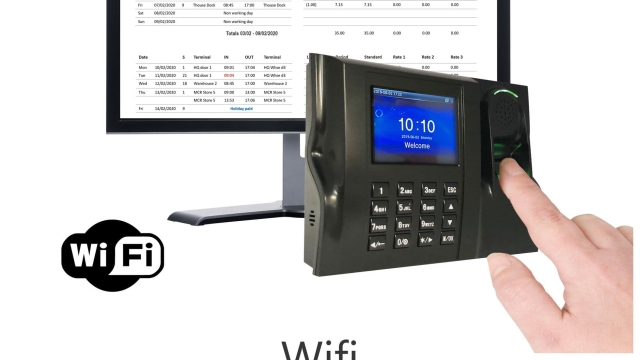In today’s fast-paced work environment, efficiency and time management are keys to success. As businesses strive to optimize their operations and increase productivity, clocking in machines have emerged as essential tools in the modern workplace. These devices not only track employee attendance but also play a crucial role in streamlining administrative processes, reducing errors, and enhancing overall management effectiveness.
Gone are the days of punch cards and manual timekeeping that often led to inaccuracies and time theft. With advanced technology and user-friendly interfaces, clocking in machines offer a seamless way for employees to register their work hours. This transformation not only benefits employers who can better manage labor costs but also empowers employees by providing them with transparent visibility over their working hours. As we explore the impact of these innovations, it becomes clear that clocking in machines are more than just time-tracking devices; they are vital guardians of workplace efficiency.
The Evolution of Clocking In Machines
The concept of tracking employee work hours dates back centuries, with early methods relying on manual bookkeeping and attendance sheets. As businesses grew, the need for more accurate and efficient tracking systems became apparent. The first mechanical time clocks emerged in the late 19th century, allowing employees to punch in and out using a simple card system. This innovation significantly reduced the risk of errors associated with manual entries and streamlined payroll processes.
With the advent of electrical engineering, the 20th century brought about a revolution in clocking in machines. Electric time clocks featured advanced mechanisms that could print time stamps directly onto cards, offering a more reliable and tamper-proof solution. This era also witnessed the integration of knobs and levers that allowed for more straightforward operation. As industries expanded, these machines became essential tools in ensuring that employees were accurately compensated for their work hours.
The introduction of computerized systems in the late 20th century marked the next phase in the evolution of clocking in machines. These digital devices not only recorded time with precision but also provided advanced features such as data storage and integration with payroll software. The shift from mechanical to digital technologies paved the way for innovative solutions, including biometric recognition and mobile clocking systems, which are now commonplace in many workplaces. These advancements have fundamentally changed how organizations manage timekeeping, enhancing overall productivity and efficiency.
Features and Technologies of Modern Devices
https://timesystemsuk.com
Modern clocking in machines come equipped with a range of features designed to streamline the process of timekeeping and enhance workplace efficiency. One of the key advancements is biometric technology, which includes fingerprint scanners and facial recognition systems. This not only ensures accurate identification of employees but also reduces instances of buddy punching, where one employee clocks in for another. By utilizing these methods, employers can maintain precise attendance records while ensuring the security and authenticity of the clocking process.
Another significant feature is the integration of cloud-based systems, which allow real-time data access and management from any location. This technology enables businesses to monitor attendance and hours worked instantly, facilitating better payroll processing and compliance with labor regulations. Employers can generate detailed reports, track labor costs, and analyze attendance patterns, empowering them to make informed decisions about staffing and workflow adjustments.
Moreover, modern clocking in machines often include user-friendly interfaces and mobile applications that enhance employee engagement. These tools allow workers to clock in and out seamlessly, request time off, and even review their work hours directly from their smartphones. This ease of use not only improves the overall experience for employees but also encourages timely clocking and reduces administrative burdens for HR departments. As technology continues to evolve, these devices are becoming more intuitive, ensuring that they meet the dynamic needs of contemporary workplaces.
Impact on Employee Productivity
The introduction of clocking in machines has significantly transformed employee productivity across various industries. By automating attendance tracking, these devices minimize the time employees spend managing their hours, allowing them to focus more on their core responsibilities. As workers clock in and out seamlessly, they can maintain a consistent work rhythm, reducing the distractions that often accompany manual timekeeping methods.
Moreover, clocking in machines contribute to a greater sense of accountability among employees. When individuals know that their attendance and punctuality are being monitored, they are more likely to arrive on time and manage their schedules effectively. This heightened sense of responsibility not only enhances individual performance but also fosters teamwork, as employees are aware that their reliability impacts the overall productivity of their team.
Finally, the data collected from clocking in machines can be analyzed to identify trends and areas for improvement within the workplace. Employers can gain insights into peak productivity times, employee attendance patterns, and the overall effectiveness of their workforce. Armed with this information, management can make informed decisions that optimize workflow and enhance productivity, ultimately contributing to the organization’s success.
Integration with Workforce Management Systems
The integration of clocking in machines with workforce management systems streamlines the process of tracking employee hours and attendance. By connecting these machines to a centralized software platform, managers can easily monitor and analyze attendance data in real time. This integration eliminates the need for manual data entry, significantly reducing errors and saving valuable time for HR departments. The automated synchronization ensures that all employee hours are accurately recorded, which enhances payroll accuracy and compliance.

Another advantage of integrating clocking in machines with workforce management systems is the improved visibility it provides for management. Supervisors can access comprehensive analytics regarding employee attendance patterns, overtime, and absenteeism. This data enables informed decision-making regarding staffing levels, scheduling, and employee performance. When managers have clear insights into attendance trends, they can proactively address potential issues and foster a more productive work environment.
Furthermore, integrating clocking in machines with workforce management systems enhances employee accessibility and engagement. Employees can easily check their attendance records, request time off, or adjust their schedules through user-friendly interfaces. This level of accessibility empowers employees, making them feel more involved in their work-life balance. Overall, this integration fosters a culture of transparency and accountability, ultimately contributing to higher workplace efficiency and satisfaction.
Future Trends in Time Tracking
As technology continues to evolve, the future of clocking in machines is poised for transformation. One significant trend is the integration of artificial intelligence and machine learning. These advancements will allow for more precise tracking of employee hours and activities, automatically adjusting for variances and irregularities. This data-driven approach can help organizations identify patterns in employee productivity, optimize workforce management, and even predict future staffing needs based on real-time analytics.
Another emerging trend is the shift towards mobile and cloud-based solutions. With the increasing reliance on smartphones and tablets in the workplace, clocking in machines are becoming more versatile. Employees will have the ability to clock in and out from their personal devices, making time tracking more convenient and accessible. This decentralization not only enhances employee autonomy but also facilitates remote work arrangements, creating a seamless experience irrespective of location.
Additionally, biometric technology is expected to become more prevalent in time tracking systems. Fingerprint scanners, facial recognition, and even retinal scans offer higher security and accuracy levels compared to traditional methods. This progression not only reduces instances of buddy punching but also streamlines the clocking in process, allowing employees to focus on their tasks rather than administrative hurdles. As these technologies advance, businesses will likely see improvements in both efficiency and employee satisfaction.



